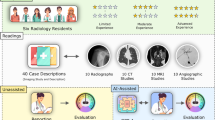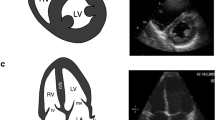Abstract
Purpose
The purpose of this study was to examine the effects of using an ultrasound phantom (ECHOZY) and a volume navigation system (Vnavi) in abdominal ultrasonography training for young residents.
Methods
Nine third-year residents underwent abdominal ultrasonography training: controls, comprising five residents; and the ECHOZY + Vnavi group, comprising four residents. Residents were trained in abdominal ultrasound examinations using both educational videos and hands-on clinical training. The ECHOZY + Vnavi group also received training using an ultrasound phantom and volume navigation system. The time needed for abdominal ultrasound examination was calculated at 4 months (early), 8 months (middle), and 12 months (late) after starting training. The ability of each resident to visualize 20 abdominal structures on normal patients was also evaluated retrospectively.
Results
In the early period, the ECHOZY + Vnavi group needed significantly longer to complete examinations than controls (545 ± 125 s versus 392 ± 81 s, p < 0.01), but showed significantly better ability scores (17.5 ± 0.6 versus 13.4 ± 1.1, p < 0.05). Both these differences disappeared by the middle period (338 ± 107 s versus 259 ± 130 s and 17.8 ± 0.5 versus 16.0 ± 0.7).
Conclusion
In spite of longer examination times, training residents in abdominal ultrasonography using an ultrasound phantom and volume navigation system may be useful in the early period.





Similar content being viewed by others
References
Angtuaco TL, Hopkins RH, DuBose TJ, et al. Sonographic physical diagnosis 101: teaching senior medical students basic ultrasound scanning skills using a compact ultrasound system. Ultrasound Q. 2007;23:157–60.
de Casasola Garcia, Sanchez G, Torres Macho J, Casas Rojo JM, et al. Abdominal ultrasound and medical education. Rev Clin Esp (Barc). 2014;214:131–6.
Swamy M, Searle RF. Anatomy teaching with portable ultrasound to medical students. BMC Med Educ. 2012;12:99.
Stringer MD, Duncan LJ, Samalia L. Using real-time ultrasound to teach living anatomy: an alternative model for large classes. N Z Med J. 2012;125:37–45.
Dreher SM, DePhilip R, Bahner D. Ultrasound exposure during gross anatomy. J Emerg Med. 2014;46:231–40.
Counselman FL, Sanders A, Slovis CM, et al. The status of bedside ultrasonography training in emergency medicine residency programs. Acad Emerg Med. 2003;10:37–42.
Terkamp C, Kirchner G, Wedemeyer J, et al. Simulation of abdomen sonography. Evaluation of a new ultrasound simulator. Ultraschall Med. 2003;24:239–44.
Maul H, Scharf A, Baier P, et al. Ultrasound simulators: experience with the SonoTrainer and comparative review of other training systems. Ultrasound Obstet Gynecol. 2004;24:581–5.
Knudson MM, Sisley AC. Training residents using simulation technology: experience with ultrasound for trauma. J Trauma. 2000;48:659–65.
Zagzebski JA, Madsen EL, Frank GR. A teaching phantom for sonographers. J Clin Ultrasound. 1991;19:27–38.
Kunishi Y, Numata K, Morimoto M, et al. Efficacy of fusion imaging combining sonography and hepatobiliary phase MRI with Gd-EOB-DTPA to detect small hepatocellular carcinoma. AJR Am J Roentgenol. 2012;198:106–14.
Toshikuni N, Tsutsumi M, Takuma Y, et al. Real-time image fusion for successful percutaneous radiofrequency ablation of hepatocellular carcinoma. J Ultrasound Med. 2014;33:2005–10.
Ewertsen C, Saftoiu A, Gruionu LG, et al. Real-time image fusion involving diagnostic ultrasound. AJR Am J Roentgenol. 2013;200:W249–55.
Makino Y, Imai Y, Igura T, et al. Usefulness of the multimodality fusion imaging for the diagnosis and treatment of hepatocellular carcinoma. Dig Dis. 2012;30:580–7.
Author information
Authors and Affiliations
Corresponding author
Ethics declarations
Conflict of interest
Chizu Uetake, Akihiro Nakamoto, Toshikuni Suda, and Masaya Tamano declare that they have no conflicts of interest.
Ethical standards
All procedures followed were in accordance with the ethical standards of the responsible committee on human experimentation (institutional and national) and with the Helsinki Declaration of 1975, as revised in 2008. Informed consent was obtained from all residents for being included in the study.
About this article
Cite this article
Uetake, C., Nakamoto, A., Suda, T. et al. Abdominal ultrasound examination training using an ultrasound phantom and volume navigation system. J Med Ultrasonics 43, 381–386 (2016). https://doi.org/10.1007/s10396-016-0706-0
Received:
Accepted:
Published:
Issue Date:
DOI: https://doi.org/10.1007/s10396-016-0706-0




